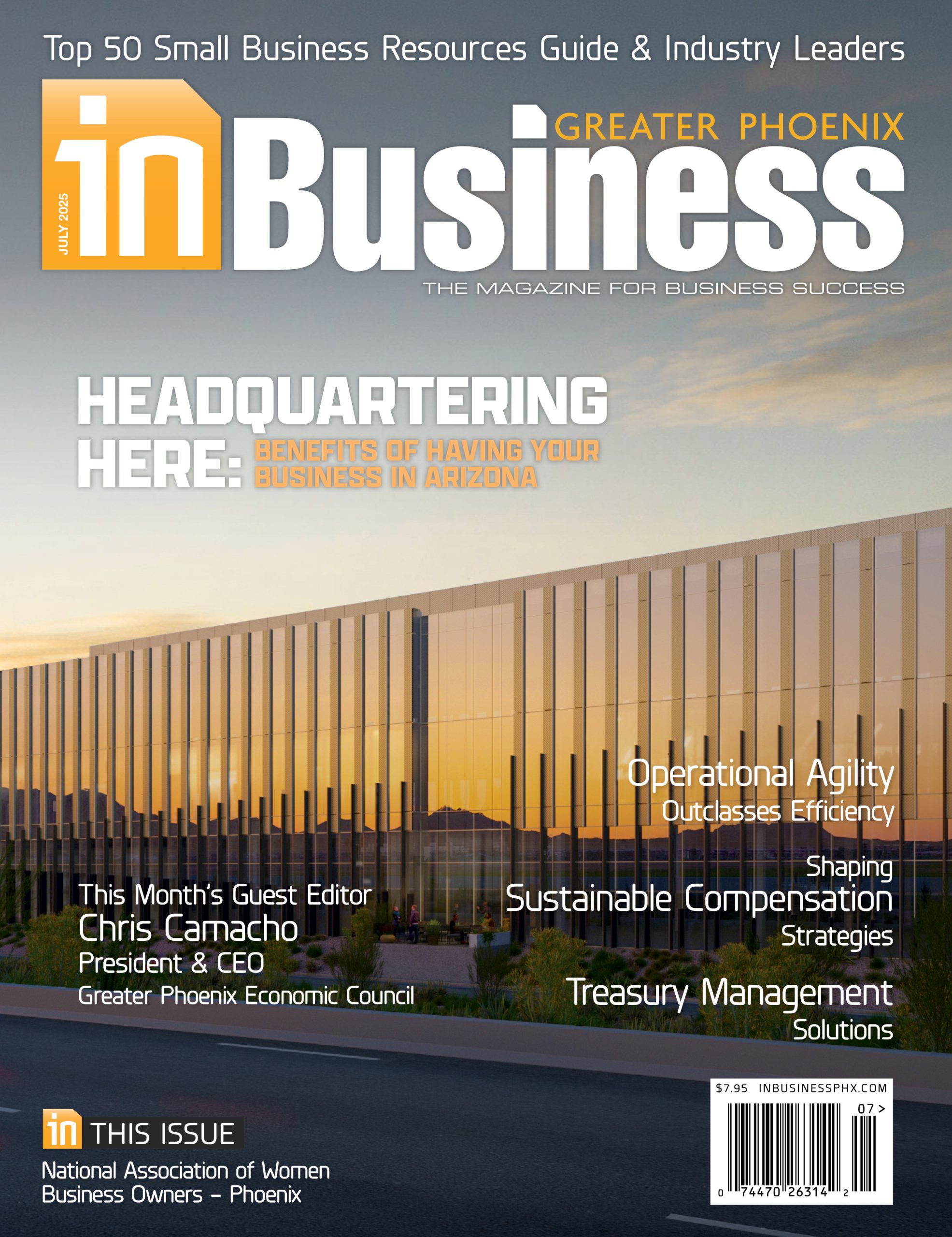Metro Phoenix ranks second in the data center development pipeline, according to the new JLL North America Data Center Report – Midyear 2025. This places the Valley in a prime position as the North America Data Center colocation market reaches a critical tipping point, with vacancy rates plummeting to an unprecedented 2.3% amid relentless demand for digital infrastructure.
Among all planned North America data center development, Northern Virginia leads all markets with 5.9 GW planned, followed by Phoenix (4.2 GW), Dallas-Fort Worth (3.9 GW) and Las Vegas/Reno (3.5 GW).
The report also highlights how cloud providers and technology companies continue to dominate data center demand, accounting for 65% of all leasing activity.
“The colocation market is experiencing unprecedented demand pressure under an increasingly stressful environment,” said Andy Cvengros, Executive Managing Director, Co-Lead of U.S. Data Center Markets, JLL. “The first half of the year was riddled with disruptions, including the DeepSeek news at the beginning of the year and the potential impact of tariffs on demand and construction. Despite the turbulence, the sector posted another record-shattering performance.”
The North American data center market absorbed an impressive 2.2 GW in H1, putting the sector on pace to exceed 2024’s record absorption levels. Phoenix represented 10MW of that space – a notably low figure that reflects strong preleasing in previous years as operators work to meet building delivery timelines.
The construction pipeline has ballooned as well to 7.8 GW, approximately 10 times the volume from five years ago. Phoenix (1.3 GW) leads construction activity followed by Chicago (1.18 GW), Atlanta (1.11 GW) and Northern Virginia (1.06 GW).
More concerning for those seeking space is that 73% of all North America data center capacity under construction is already preleased. High preleasing has remained consistent for the past two years, signaling meaningful market relief remains years away.
“With a metro Phoenix data center vacancy rate of just 3%, or 31 MW, operators have recognized the need to plan ahead,” said Mark Bauer, Vice Chairman and Data Center Leader at JLL. “Most of the major deliveries that we have scheduled to deploy in early 2026 are preleased. That will keep vacancy constrained through 2026. Colocation users have recognized that they must capitalize quickly on any availability greater than 5 MW, and hyperscale companies are moving at equal speed to secure new capacity – whether that means acquiring space within Phoenix or moving to its outer submarkets like Avondale and Buckeye for the campus acreage they need.”
“What we’re seeing now is ‘commit-before-it’s-built-or-you-won’t-get-in.’ This is fundamentally changing how companies approach their data center strategies,” said Matt Landek, Division President, U.S. Data Center Work Dynamics, who also leads JLL’s Data Center Project Development and Services. “Enterprise users who once planned 6 to 12 months in advance are now securing capacity and their facilities and operations teams 18 to 24 months before their intended deployment dates, sometimes even earlier.”
Commercial electricity rates have risen nearly 30% since 2020, reaching an average of 9.7 cents/kWh in H1 2025. This increasing cost pressure has driven development toward markets with lower power costs such as Salt Lake City (5.7 cents/kWh) and Denver (6.4 cents/kWh). Phoenix ranks positively within that spectrum, at 7.5 cents/kWh.
The average wait time for a grid connection across the U.S. is now four years. Power delays remain a significant hurdle in alleviating supply constraints. However, there is a silver lining, this obstacle is also preventing a bubble from forming in the sector.
“In Phoenix, operators are acquiring sites today with the expectation of future tranches of power. At the same time, local utility companies are shifting how they conduct power studies and requiring additional upfront funding and planning for sites to be included in those studies,” said Bauer.
“Power has become the new real estate,” said Andrew Batson, Head of U.S. Data Center Research at JLL. “With vacancy effectively at 0%, virtually all absorption is the result of preleasing with delivery times extending beyond 12 months. The North American market has been growing at a remarkable 20% CAGR since 2017, and our development pipeline data suggests this pace will continue through 2030, with the colocation market potentially expanding to 42 GW of capacity.”
The data center sector continues to solidify its position as one of the most favored real estate asset classes, with market capitalization growth of 161% since 2019, second only to industrial properties. This remarkable growth is driven by insatiable tenant demand, limited supply and rising rents, creating a compelling investment thesis that continues to attract new capital to the sector.
“There was a significant increase in the amount of capital deployed into data center projects under construction or reaching stabilization in the first half of 2025 compared to the previous year” said Carl Beardsley, Senior Managing Director, Data Center Leader, JLL Capital Markets. “We’re seeing developments with long-term leases achieving up to 85% loan-to-cost from senior lenders at competitive spreads, while new entrants to the lending market are pushing greater flexibility in terms, higher leverage options and increasingly creative structures at stabilization.”
The debt markets for data centers are experiencing significant expansion, with asset-backed security (ABS) and single-asset single-borrower (SASB) loan activity increasing for the third consecutive year. The first half of 2025 saw 14 ABS deals totaling $7.7 billion and four SASB deals totaling $5.7 billion, substantial increases from the same period in 2024. Meanwhile, asset-level investment sales remained relatively muted at $754 million across 23 transactions in H1 2025, with average cap rates holding steady around 6%, comparable to premium industrial and multi-housing properties.
Looking ahead, JLL anticipates the supply-demand imbalance to persist over the next several years. Projects already under construction are 73% preleased, and while an additional 31.6 GW of capacity is planned, that supply will be phased over five years or more.
“Phoenix has cemented itself as a top-tier data center hub, blending low-latency access to the West Coast, competitive power infrastructure and pro-business policies with room for growth,” said Bauer. “With 1,307 MW under construction, 4,154 MW planned and AI driving demand, operators are securing land today to capture tomorrow’s opportunity.”
The combination of AI adoption, digital transformation initiatives and cloud migration has created a perfect storm of demand that the industry simply cannot meet quickly enough, leading to the current supply crunch and making forward planning more crucial than ever for enterprises seeking data center capacity.




















